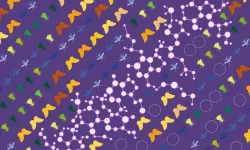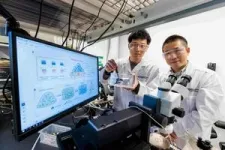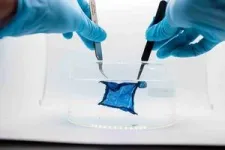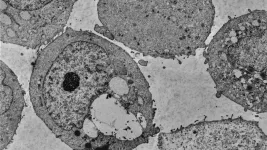(Press-News.org) Few people are fans of stink bugs, mosquitoes, or boll weevils, but insects play a key role in the circle of life that makes up the planet’s environment. In fact, world-renowned biologist E. O. Wilson famously declared that if insects vanished, our environment would collapse.
Scientists have noted that insect behaviour has been changing, and their populations are declining – on average 2-3% per year. This has prompted them to investigate the potential causes of this change, such as habitat loss due to overdevelopment, climate change, and chemical use.
EMBL researchers and collaborators recently investigated how pesticides, herbicides, and other agrochemicals affect insect populations. They systematically exposed fruit fly larvae to more than 1,000 molecules contained within EMBL’s unique chemical library, which stores a variety of agrochemicals in a format readily usable for large-scale screens.
These fruit fly larvae came from multiple geographic locations, and the researchers followed their developmental time, behaviour, and long-term survival for the duration of their life cycle. They found that 57% of the tested chemicals altered fruit fly larvae behaviour significantly even in amounts known not to be fatal. A higher level of chemicals compromised long-term survival of the flies after this same kind of exposure.
“We found that when we exposed larvae to very low doses of chemicals, the exposure caused widespread changes in physiological processes that are at the heart of how they develop and behave,” said Lautaro Gandara, first author of a paper reporting these findings in the journal Science and postdoctoral fellow in EMBL’s Crocker research group. “These changes were exacerbated when we increased the temperature in the growing chambers by four degrees – a decision born from the idea that global temperatures have been on the rise and might affect how pesticides affect the larvae.”
The scientists started by raising the temperature in the growing environment by two degrees (from 25°C/77°F to 27°C/80.6°F). When they didn't see much difference, they increased the temperature further to 29°C/84.2°F, which is still representative of summer temperature ranges for much of the world. At that point, they saw a pronounced impact.
“Further, we mixed some of the most commonly detected airborne chemicals, at ecologically relevant doses, again exposing fruit flies from when they first hatched. We then saw a much stronger effect,” said Justin Crocker, EMBL Group Leader and senior author of the recent scientific paper. “We observed a 60% drop in egg-laying rates, foreshadowing population decline but also other altered behaviours, such as more frequent hunching, a behaviour rarely seen in the untreated groups.”
‘Hunching' is when larvae bend or curl their bodies in an exaggerated manner. It can signal stress or discomfort, but more importantly, underlying issues such as toxicity, neurological effects, or physiological processes that have been disrupted.
“On the surface, hunching may seem inconsequential, but even small changes in behaviour can impact fitness if they adversely affect feeding, mating, and migration, for example,” Crocker added. “Scientists need to understand how animals interact with each other and their environment to predict the impact of changes, such as habitat destruction or climate change, on ecosystems.”
The scientists acknowledged they don’t yet know if this hunching is connected to other changes they found, like the reduced egg-laying rate. It's possible the two behaviours are unrelated. Despite that, it's likely that larvae that spend a lot of time hunching instead of eating won't thrive in a natural environment.
Gandara and Crocker teamed up with several other scientists for this study. Jean-Baptiste Masson and François Laurent from the Pasteur Institute, along with Christian Tischer’s team at EMBL, provided AI-driven approaches to understand behavioural effects with high statistical resolution. Other EMBL collaborators included the Zimmermann Group, with its chemical library, the Savitski Group for proteomics expertise, and the Zimmermann-Kogadeeva group for computational biology expertise.
Collaborators Vicky Ingham, a group leader at Heidelberg University Hospital, and Arnaud Martin, an associate professor in Biology at George Washington University, helped the EMBL researchers expand their experiment’s scope to include mosquitoes and Painted Lady butterflies, respectively, where they found similar patterns and were thus able to validate the experimental approach and conclusions.
“Insects – even those that can seem like pests – are critical to the planet. They pollinate the plants we eat and they’re an important part of the food web,” Gandara said. “For a long time, people speculated on the various reasons for insect behaviour changes, but now this research helps clarify one significant contributing factor. One of the biggest takeaways from this work is that even small amounts of certain chemicals have impacts.”
Animal behaviour plays a crucial role in maintaining ecosystem balance. Additionally, as insect populations decline, so too does genetic diversity, which is critical for species to adapt to environmental changes presently and in the future.
“The positive aspect to this work is that we have new knowledge about which chemicals can cause certain molecular changes and associated behavioural and developmental changes,” Crocker said. “By providing data on the impact and toxicity of chemicals, these assays can translate into regulatory and industrial practices that better protect human health and the environment.”
END
Evaluating the link between chemicals and declining insect populations
Using a library of 1,000+ agrochemicals, scientists saw significant changes in behaviour and long-term survival of different insect populations
2024-10-24
ELSE PRESS RELEASES FROM THIS DATE:
Scientists discover molecules that store much of the carbon in space
2024-10-24
A team led by researchers at MIT has discovered that a distant interstellar cloud contains an abundance of pyrene, a type of large, carbon-containing molecule known as a polycyclic aromatic hydrocarbon (PAH).
The discovery of pyrene in this far-off cloud, which is similar to the collection of dust and gas that eventually became our own solar system, suggests that pyrene may have been the source of much of the carbon in our solar system. That hypothesis is also supported by a recent finding that samples returned from the near-Earth asteroid Ryugu contain large quantities of pyrene.
“One of the big questions in ...
Sublethal agrochemical exposure disrupts insect behavior and long-term survivability
2024-10-24
Even at concentrations too low to kill, exposure to widely used agrochemicals – pesticides, herbicides, and fungicides, among others – has pervasive negative impacts on insect behavior and physiology, researchers report. The findings highlight the need for more comprehensive pesticide assessments, focusing not just on lethality but also on unintended long-term ecological harm to safeguard biodiversity. Over the past decade, many reports have highlighted alarming declines in insect ...
Understanding that US wildfires are becoming faster-moving is key to preparedness
2024-10-24
“The modern era of megafires is often defined based on wildfire size,” say Jennifer Balch and colleagues in a new study, “but it should be defined based on how fast fires grow and their consequent societal impacts.” Balch and colleagues report that wildfire growth rates in the U.S. have surged over 250% over the last 2 decades. Although these fast-moving infernos, or “fast fires” – those spreading more than 1,620 hectares in a day – account for only 2.7% of wildfire events from 2001 to 2020, researchers report that they are responsible for 89% of the total structures damaged ...
Model predicts PFAS occurrence in groundwater in the US
2024-10-24
According to a new machine learning-assisted predictive model, as many as 95 million Americans may rely on groundwater containing PFAS for their drinking water supplies before any treatment, researchers report. This raises concerns about unmonitored contamination in domestic and public water supplies. Per- and polyfluoroalkyl substances (PFAS), often called “forever chemicals,“ are highly persistent environmental contaminants linked to adverse environmental and health effects. Used in many consumer products, these organic pollutants have become ubiquitous in the environment and ...
By studying new species of tardigrade, researchers glean insights into radiation tolerance
2024-10-24
Tardigrades, eight-legged microorganisms colloquially known as “water bears,” are the most radiation-tolerant animals on Earth. Now, by studying a newly identified species of tardigrade, researchers have gleaned valuable insights into the animal’s ability to withstand radiation. These findings hold implications for safeguarding human health in extreme environments, such as spaceflight. Roughly 1,500 species of tardigrades have been described. These creatures can endure gamma radiation ...
Plastic chemical causes causes DNA breakage and chromosome defects in sex cells
2024-10-24
A new study conducted in roundworms finds that a common plastic ingredient causes breaks in DNA strands, resulting in egg cells with the wrong number of chromosomes. Monica Colaiácovo of Harvard Medical School led the study, which was published October 24 in the journal PLOS Genetics.
Benzyl butyl phthalate (BBP) is a chemical that makes plastic more flexible and durable, and is found in many consumer products, including food packaging, personal care products and children’s toys. Previous studies have shown that BBP interferes with ...
Vitamin K supplement slows prostate cancer in mice
2024-10-24
Prostate cancer is a quiet killer. In most men, it’s treatable. However, in some cases, it resists all known therapies and turns extremely deadly. A new discovery at Cold Spring Harbor Laboratory (CSHL) points to a potentially groundbreaking solution. CSHL Professor Lloyd Trotman’s lab has found that the pro-oxidant supplement menadione slows prostate cancer progression in mice. The supplement is a precursor to vitamin K, commonly found in leafy greens. The story begins more than two decades ago.
In 2001, the National Cancer Institute’s SELECT trial sought to determine if an antioxidant ...
Wildfires are becoming faster and more dangerous in the Western U.S.
2024-10-24
Fast-growing fires were responsible for nearly 90 percent of fire-related damages despite being relatively rare in the United States between 2001-2020, according to a new study led by the University of Colorado Boulder. “Fast fires,” which thrust embers into the air ahead of rapidly advancing flames, can ignite homes before emergency responders are able to intervene. The work, published today in Science, shows these fires are getting faster in the Western U.S., increasing the risk for millions of people.
The research highlights a critical gap in hazard preparedness across the U.S. — National-level ...
Gut bacteria transfer genes to disable weapons of their competitors
2024-10-24
Bacteria evolve rapidly in the human gut by sharing genetic elements with each other. Bacteriodales is a prolific order of gut bacteria that trade hundreds of genetic elements. Little is known, however, about the effects of these DNA transfers, either to the fitness of the bacteria or the host.
New research from the University of Chicago shows that a large, ubiquitous mobile genetic element changes the antagonistic weaponry of Bacteroides fragilis, a common bacterium of the human gut. Acquisition of this element shuts down a potent weapon ...
A new hydrogel semiconductor represents a breakthrough for tissue-interfaced bioelectronics
2024-10-24
The ideal material for interfacing electronics with living tissue is soft, stretchable, and just as water-loving as the tissue itself—in short, a hydrogel. Semiconductors, the key materials for bioelectronics such as pacemakers, biosensors, and drug delivery devices, on the other hand, are rigid, brittle, and water-hating, impossible to dissolve in the way hydrogels have traditionally been built.
A paper published today in Science from the UChicago Pritzker School of Molecular Engineering (PME) has solved this challenge that has long ...
LAST 30 PRESS RELEASES:
New technique lights up where drugs go in the body, cell by cell
New study finds movement of fishing fleets can reveal shifts in marine ecosystems
Embargoed: New evidence points to potential treatment for vascular dementia
Study uncovers disrupted brain balance in alcohol dependence
Working in groups can help Republicans and Democrats agree on controversial content moderation online
Structural findings reveal how distinct GPCR ligands create different levels of activation
Anything-goes “anyons” may be at the root of surprising quantum experiments
UC review: Maximizing workplace opportunity for veterans
From generation to complex control: Metasurfaces make perfect vortex beams "within reach"
Thin-film lithium niobate-based detector: recent advances and perspectives
Exploring why some people may tend to persistently make bad choices
How cells balance their protein levels
Nirsevimab vs RSVpreF vaccine for RSV–related hospitalization in newborns
Effectiveness and impact of maternal RSV immunization and nirsevimab on medically attended RSV in US children
AI gives scientists a boost, but at the cost of too many mediocre papers
Next-generation vision model maps tree growth at sub-meter precision
Genes aren’t destiny for inherited blindness, study shows
MIT study: High-fat diets make liver cells more likely to become cancerous
Exposure to multiple fine particulate matter components and incident depression in the US Medicare population
Risk of burdensome health care spending over time in the US
Nirsevimab against hospitalizations and emergency department visits for lower respiratory tract infection in infants
New microfluidics technology enables highly uniform DNA condensate formation
A new strategy for immune tolerance
Super Mario Bros. help fight burnout: New study links classic games to boosted happiness
Deepest gas hydrate cold seep ever discovered in the arctic: International research team unveils Freya Hydrate Mounds at 3,640 m depth.
Integrating light and structure: Smarter mapping for fragile wetland ecosystems
ACA-SIM: A robust way to decode satellite signals over complex waters
Probiotics can restore gut microbiome in breastfed infants
AI could help predict nutrition risks in ICU patients, study finds
Federal EITC has unexpected result, researchers say – it decreases domestic violence
[Press-News.org] Evaluating the link between chemicals and declining insect populationsUsing a library of 1,000+ agrochemicals, scientists saw significant changes in behaviour and long-term survival of different insect populations




